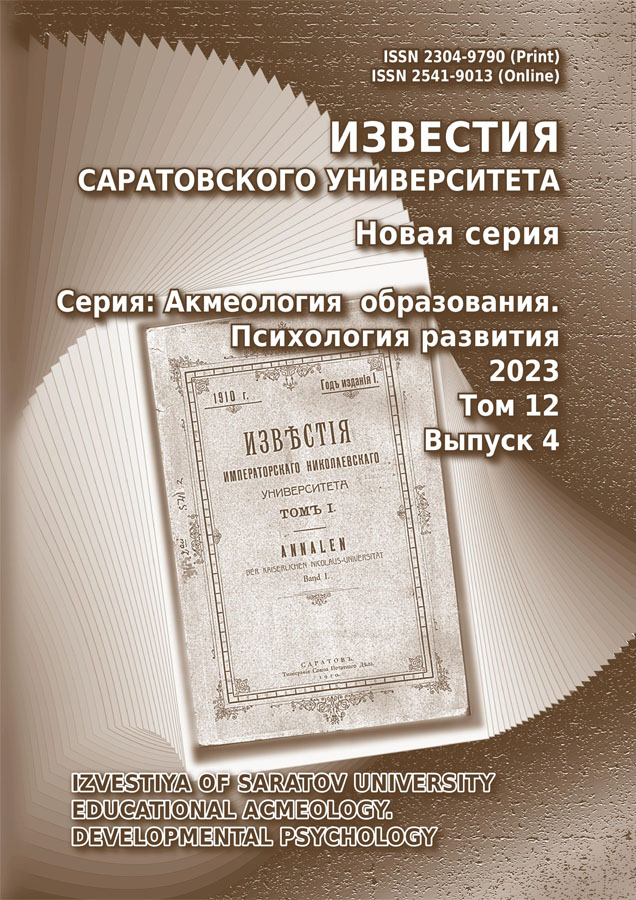Overcoming stressful situations and professional burnout of nurses: Analysis of the network
- Authors: Leonov I.N.1
-
Affiliations:
- Udmurt State University
- Issue: Vol 12, No 4 (2023)
- Pages: 336-347
- Section: Articles
- URL: https://journal-vniispk.ru/2304-9790/article/view/251097
- DOI: https://doi.org/10.18500/2304-9790-2023-12-4-336-347
- EDN: https://elibrary.ru/JOZDGL
- ID: 251097
Cite item
Full Text
Abstract
About the authors
Ilya N. Leonov
Udmurt State University
ORCID iD: 0000-0002-7254-6374
1/6 Universitetskaya st.
References
- Водопьянова Н. Е., Старченкова Е. С. От выгорания к обновлению: опыт и перспективы изучения синдрома выгорания в России // Национальный психологический журнал. 2006. № 1. С. 126–130. EDN: XJMLAP
- Fernet C., Senecal C., Guay F., March H., Dowson M. The Work Tasks Motivation Scale for Teachers (WTMST) // Journal of Career Assessment. 2008. Vol. 16, iss. 2. P. 256‒279. https://doi.org/10.1177/1069072707305764
- Jayaratne S., Chess W. A. Job satisfaction, burnout, and turnover: A national study // Social Work. 1984. Vol. 29, iss. 5. P. 448–453. https://doi.org/10.1093/sw/29.5.448
- Maslach C., Jackson S. E. The measurement of experienced burnout // Journal of Occupational Behavior. 1981. Vol. 2, iss. 2. P. 99‒113. https://doi.org/10.1002/job.4030020205
- Maslach C. Burnout: The Cost of Caring. Englewood Cliffs, NJ : Prentice Hall, 1982. 192 p.
- Rupert P. A., Morgan D. J. Work setting and burnout among professional psychologists // Professional Psychology: Research and Practice. 2005. Vol. 36, iss. 5. P. 544‒550. https://doi.org/10.1037/0735-7028.36.5.544
- Schaufeli W. B., Buunk B. P. Burnout: An overview of 25 years of research and theorizing // The Handbook of Work and Health Psychology / ed. by M. J. Schabracq, J. A. M. Winnubst, C. L. Cooper. 2nd ed. Chichester, UK : John Wiley & Sons, Ltd, 2002. Chapt. 19. P. 383‒425. https://doi.org/10.1002/0470013400.ch19
- Beehr T. A., Johnson L. B., Nieva R. Occupational stress: Coping of police and their spouses // Journal of Organizational Behavior. 1995. Vol. 16, iss. 1. P. 3‒25. https://doi.org/10.1002/job.4030160104
- Alarcon G., Eschleman K. J., Bowling N. A. Relationships between personality variables and burnout: A meta-analysis // Work & Stress. 2009. Vol. 23, iss. 3. P. 244–263. https://doi.org/10.1080/02678370903282600
- Ермолаева Е. П. Совладание как механизм реализации профессионала в условиях глобальных перемен // Стресс, выгорание, совладание в современном контексте/ под. ред. А. Л. Журавлева, Е. А. Сергиенко. М. : Институт психологии РАН, 2011. С. 336‒354. EDN: TRAKRL
- González-Morales M. G., Rodríguez I., Peiró J. M. A longitudinal study of coping and gender in a femaledominated occupation: Predicting teachers’ burnout // Journal of Occupational Health Psychology. 2010. Vol. 15, iss. 1. P. 29‒44. https://doi.org/10.1037/a0018232
- Jenaro C., Flores N., Arias B. Burnout and coping in human service practitioners // Professional Psychology: Research and Practice. 2007. Vol. 38, iss. 1. P. 80‒87. https://doi.org/10.1037/0735-7028.38.1.80
- Lazarus R. S., Folkman S. Stress, Appraisal, and Coping. New York, NY : Springer Publishing Company, 1984. 456 p.
- Tobin D. L., Holroyd K. A., Reynolds R. V., Wigal J. K. The hierarchical factor structure of the Coping Strategies Inventory // Cognitive Therapy and Research. 1989. Vol. 13, iss. 4. P. 343–361. https://doi.org/10.1007/BF01173478
- Marroquín B. M., Fontes M., Scilletta A., Miranda R. Ruminative subtypes and coping responses: Active and passive pathways to depressive symptoms // Cognition and Emotion. 2010. Vol. 24, iss. 8. P. 1446–1455. https:// doi.org/10.1080/02699930903510212
- Janke W., Erdmann G., Kallus K. W. Stressverarbeitungsfragebogen mit SVF 120 und SVF 78. Göttingen : Hogrefe, 2002. 97 S.
- Perlman B., Hartman E. A. Burnout: Summary and future research // Human Relations. 1982. Vol. 35, iss. 4. P. 283–305. https://doi.org/10.1177/001872678203500402
- Shin H., Park Y. M., Ying J. Y., Kim B., Noh H., Lee S. M. Relationships between coping strategies and burnout symptoms: A meta-analytic approach // Professional Psychology: Research and Practice. 2014. Vol. 45, iss. 1. P. 44–56. https://doi.org/10.1037/a0035220
- Van Der Maas H. L. J., Dolan C. V., Grasman R. P., Wicherts J. M., Huizenga H. M., Raijmakers M. E. A dynamical model of general intelligence: The positive manifold of intelligence by mutualism // Psychological Review. 2006. Vol. 113, iss. 4. P. 842‒861. https://doi.org/10.1037/0033-295X.113.4.842
- Borsboom D., Cramer A. O. Network analysis: An integrative approach to the structure of psychopathology // Annual Review of Clinical Psychology. 2013. Vol. 9, iss. 1. P. 91‒121. https://doi.org/10.1146/annurevclinpsy-050212-185608
- Costantini G., Epskamp S., Borsboom D., Perugini M., Mottus R., Waldorp L., Cramer A. State of the aRt personality research: A tutorial on network analysis of personality data in R // Journal of Research in Personality. 2015. Vol. 54. P. 13‒29. https://doi.org/10.1016/j.jrp.2014.07.003
- Dalege J., Borsboom D., Van Harreveld F., Van Den Berg H., Conner M., Van Der Maas H. Toward a formalized account of attitudes: The Causal Attitude Network (CAN) model // Psychological Review. 2015. Vol. 123, iss. 1. P. 2‒22. https://doi.org/10.1037/a0039802
- Kossakowski J. J., Epskamp S., Kieffer J. M., Van Borkulo C. D., Rhemtulla M., Borsboom D. The application of a network approach to Health-Related Quality of Life (HRQoL): Introducing a new method for assessing HRQoL in healthy adults and cancer patients // Quality of Life Research. 2016. Vol. 25, iss. 4. P. 781‒792. https://doi.org/10.1007/s11136-015-1127-z
- Водопьянова Н. Е. Психодиагностика стресса. СПб. : Питер, 2009. 336 с.
- Водопьянова Н. Е., Старченкова Е. С. Синдром выгорания: диагностика и профилактика. М. : Юрайт, 2023. 299 с.
- Isvoranu A.-M., Epskamp S., Waldorp L. Network Psychometrics with R: A Guide for Behavioral and Social Scientists. London : Routledge, 2022. 260 p. https://doi.org/10.4324/9781003111238
- Fruchterman T., Reingold E. Graph drawing by forcedirected placement // Software: Practice and Experience. 1991. Vol. 21, iss. 11. P. 1129‒1164. https://doi.org/10.1002/spe.4380211102
- Pons P., Latapy M. Computing communities in large networks using random walks // Journal of Graph Algorithms and Applications. 2006. Vol. 10, no. 2. P. 191‒218. https://doi.org/10.7155/jgaa.00124
- Dijkstra E. W. A note on two problems in connexion with graphs // Numerische Mathematik. 1959. Vol. 1, iss. 1. P. 269‒271. https://doi.org/10.1007/BF01386390
Supplementary files










